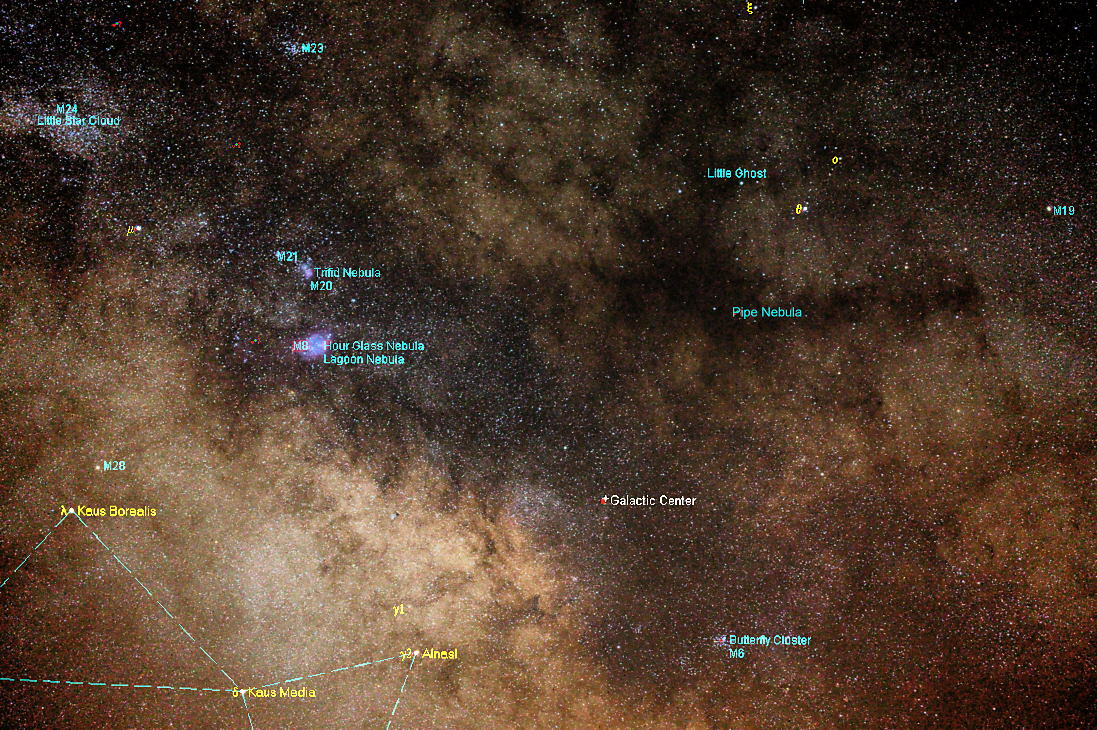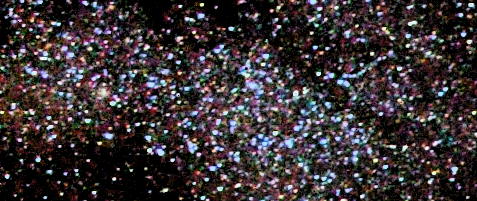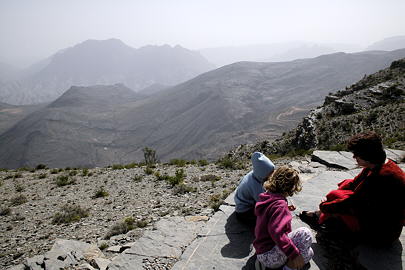
Star Party at Sharaf al Alamayn
(Night of the 29th May 2003, chasing the Galactic Center, Sagittarius A*)
OK, where on Earth is Sharaf al Alamayn?! Well, there is this rough mountain road that affords a 70km shortcut crossing of the Hajar Mountain range (the chain across North Oman), connecting the Nizwa/Bahla side to the Rustaq/Awabi (Wadi Bani Auf) side. It's only fairly recently that it's possible to drive this entire route (previously you had to walk many hours or go by donkey) but the track does save more than a couple hundred km if you have to drive from Bahla to Rustaq or vice versa. The road is currently being paved - a very challenging project. Around halfway along this mountain track, near the highest pass, there is a site suitable for camping, at an elevation of almost 2000m. That's Sharaf al Alamayn. Should be great for astronomy! Of course, as soon as our star party arrived we got clouded over and it started pouring rain! Complete with lightening and thunder. Temperature was pleasant, though, considering that we had just come from Muscat; humid, and with a temperature of 43 deg C. Not much to do but sit and wait. Luckily just as the sun was about to set, the rain stopped and the sky started clearing, with a fleeting display of crepuscular rays (who dreams up these names, anyway?):

It did clear more as the night wore on and we started observing the usual spring/summer stuff, Omega Centauri and the Virgo/Leo galaxies, etc. Nice, cool night (in the teens Centigrade). The seeing was unfortunately not quite up to the usual, high-altitude standards (you couldn't even split the Double-Double in Lyra cleanly), stuff jumping around at high magnification and a thin haze to boot. Nevertheless at around midnight I started taking photographs with a Canon 1Ds piggy-backed on my Celestron Ultima 2000-8" scope. The 1Ds is one heavy digital camera! It proved impossible to balance it satisfactorily so that it points where the scope points. Anyway I ended up resting the scope on its "downstop", and with a ball-and-socket head I could point the camera wherever I wanted. With everything so dark this is of course a bit of a guessing game. You don't see much thorough the viewfinder... Here is one quite successful image, a composite of 10 exposures each 290 seconds long, ISO 1250, Tamron 14mm lens set at f/3.5:

OK, the length of exposure was perhaps overkill (48 minutes total) but I was going by the usual adage of astrophotography. If one hour looks good, ten hours will look better; less noise, etc. I was planning to get a nice shot of the center of our galaxy, the Milky Way, and the above will serve for general orientation. The above view is of course a very wide one, 14mm ultrawide lens on a 35mm format camera; stretching from the light-polluted and hazy southern horizon (on the right) going all the way overhead and well onto the other side. I have annotated a couple of the bright stars and also the "Teapot" in Sagittarius. We are looking at our home galaxy edge-on. The center of the Milky Way has a bulge but all the dust lanes obscure the stars behind, so we do not get to see the full shape and details of our Galactic Center. The spout of the Teapot happens to point towards our Galactic Center. If you are in the southern hemisphere you can see the Milky Way continuing beyond our southern horizon, i.e. towards the right. Below is the full frame, but with much more aggressive digital processing to get rid of the light pollution, thereby allowing a higher contrast presentation:
![]()
Notice how blue-hot Vega contrasts nicely with the much cooler, red-giant Antares. The 3 bright stars Vega, Deneb and Altair constitute the easily recognizable "Summer Triangle" and reddish Mars is resplendent on its own. NB: North is towards the left. The Galactic Center itself has an interesting discovery history. It's amusing to follow our anthropocentric thinking (another nice word! meaning human-centered). Just a few hundred years ago we believed that the Earth was the center of the universe; but then Galileo and colleagues came along and we ended up having to admit that the entire Earth is going round the Sun, just one of a number of planets. So we then made the Sun the center of the universe. One day, much later, we realized that the Milky Way is somehow a vast agglomeration of stars (billions) and so we decided that the Milky Way encompassed the entire universe. No, not again! In the 1920s it was realized by Edwin Hubble that M31 was in fact a galaxy in its own right (the Andromeda Galaxy) and that the Milky Way is just one of many galaxies, in fact one of billions of galaxies, each with billions of stars, each with billions of planets (many with billions of creatures?). So much for anthropocentricity. We are, quite possibly, just a mere, puny species on an insignificant planet, going around an insignificant star, in an insignificant galaxy. But then again, our anthropocentricity may indeed be fully justified and we are the super species of the entire universe! Oh, a few centuries back some cardinal or other "calculated" that the universe was only 6000 years old. Today we believe that the universe is between 10 and 15 billion years old. Tomorrow...? OK, enough of that. It seems that radio astronomy was born because one enterprising Bell engineer was searching for what caused all the static noise that messed up Ma Bell's long distance phone system. He built a huge antenna and discovered that an awful lot of radio noise came from the constellation of Sagittarius. This powerful radio source was eventually named Sagittarius A* (pronounced A-star). It's located near the spout of that Teapot above, actually at 17h 45' 40", 29deg 0' 28". I needed the coordinates (finally got them from a Chandra X-ray satellite image) to plot it in the next photo below. Putting 2+2 together, it was subsequently realized that Sgr A* is in fact our Galactic Center, replete with a massive black hole and a huge amount of X-rays emanating from its accretion disc. Thus, unfortunately, the dust lanes hide our Galactic Center from us visually, but still, it can be observed in other wavelengths (X-rays, Infra Red, Radio). Here below is my attempt to track it down visually:

The Galactic Center is indeed well hidden but one stands in awe of all those millions of stars... Wow! This image is a composite of three 110-second exposures taken with the 1Ds at ISO 1250 and a Canon 100/2.8 macro (!) USM lens at f/3.2. I took a lot more but with the longer focal length, 100mm as opposed to the earlier 14mm, only 3 showed minimal tracking errors. Some people used to say that macro lenses are lousy for shooting star fields. Not this one! The above full-frame image is sharp corner to corner and can be printed huge. For the photographers amongst the readers, here is a 1:1 unsharpened crop of the Little Star Cloud near the top left corner of the above full frame. Note, completely unsharpened, neither in-camera nor out, and it did involve piggyback tracking too. Imagine this as a crop off a PC monitor screen 5 feet wide:

Normal lenses, even Canon primes, never mind zooms, show terrible coma near the edges in star photos when used so wide open. Below is a picture that's actually even sharper because it is not stacked, just a single frame, 110sec exposure at f3.2, ISO 1250, converted from RAW using Daylight White Balance. I shifted the colour of the Lagoon from the H-Beta blue to red; to appease all those who insist on it. Most of the other nebulae also shifted in tandem. It shows a region contiguous with, but towards the north of the previous image:

Anyway, When morning came, the crowd gathered to play with our Club's latest toy, a Coronado H-Alpha solar scope. Nice.


Being so high up in the mountains does bring with it some spectacular scenery, perhaps even the most spectacular in the Hajar mountains, well worthy of a photo trip on its own:

For more stuff return to Samir's Home
To drop me an e-mail just
click on:
samirkharusi